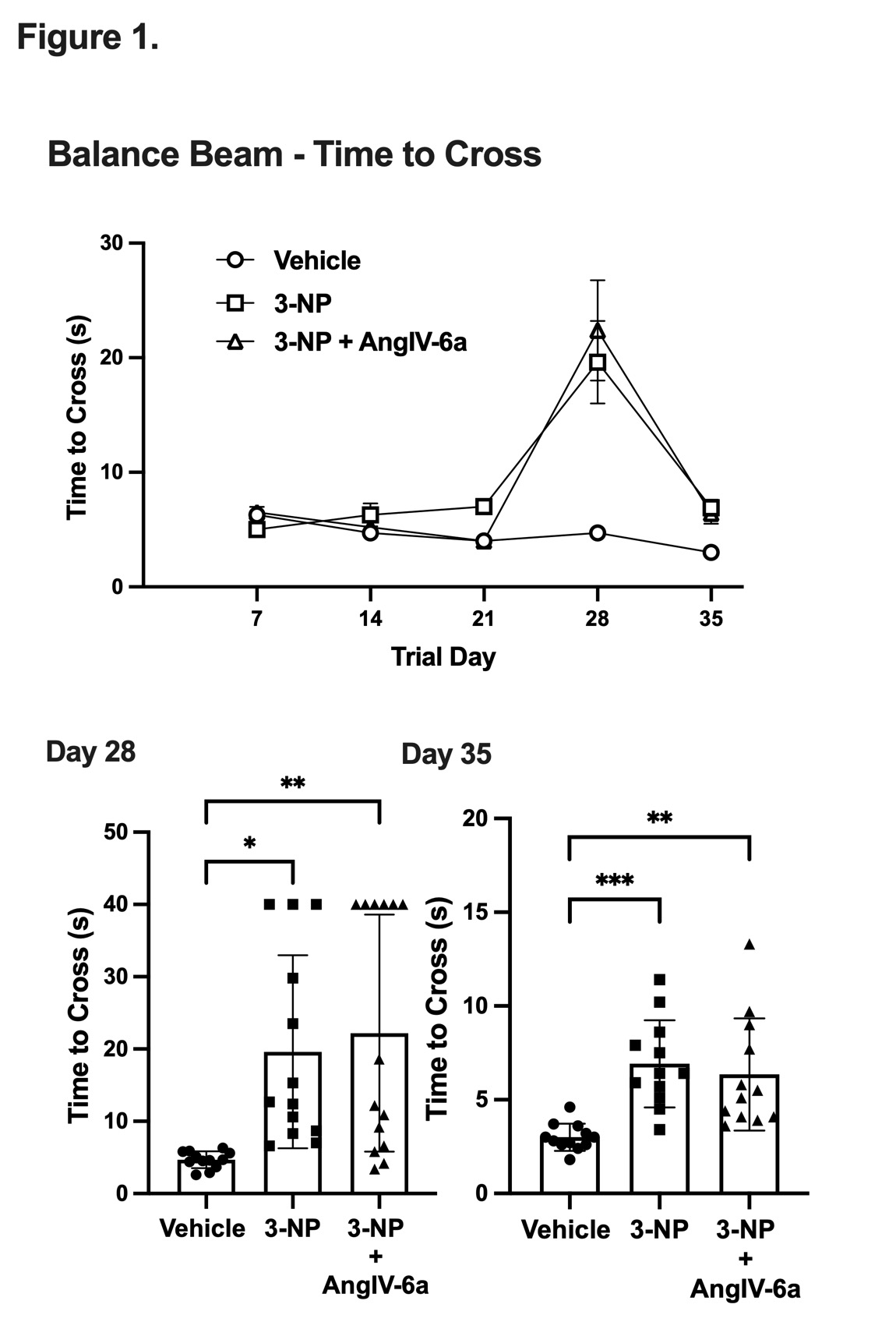Category: Huntington's Disease
Objective: The present study was designed to test if N-hexanoic-Tyr-Ile-(6)-amino hexanoic amide (AngIV-6a), an angiotensin IV analog, could attenuate 3-nitropropionic acid-induced Huntington’s disease-like symptoms in rats and serve as a potential therapeutic agent.
Background: Huntington’s disease (HD) is a neurodegenerative disorder characterized by motor, cognitive, and psychiatric dysfunction caused by a mutant huntingtin protein. The symptomatology appears at least in part related to mitochondrial dysfunction in neurons of the striatum [1,2,3,4]. Compromised metabolic activity resulting from systemic administration of the mitochondrial toxin, 3-nitropropionic acid (3-NP), is known to mimic the pathology of HD and induce HD-like symptoms in rats [5,6]. AngIV-6a has been shown to have neuroprotective and procognitive properties in animal models of Alzheimer’s and Parkinson’s disease [7]. Given the mechanism of action and success in animal models of other neurodegenerative diseases, we felt it an appropriate compound to investigate further for HD through use on an HD animal model.
Method: Forty male Wistar rats were randomized into three groups consisting of a “vehicle” group, a “3-NP” group, and a “3-NP + AngIV-6a” group. AngIV-6a was administered (intraperitoneal, four weeks, 0.5 mg/kg alternate day, one week, 0.5 mg/kg daily) along with chronic exposure of 3-NP (intraperitoneal, three weeks, daily), where 3-NP dosing was determined once behavioral impairment was observed, ranging from 10 mg/kg/day to 25 mg/kg/day. Animal body weight, motor function, and cognitive abilities were measured for five weeks, with weight measurements every third day and behavioral testing once per week before euthanasia and histopathological analysis.
Results: Exposure to 3-NP decreased the amount of weight rats gained, impaired spatial learning and memory consolidation, and led to marked motor dysfunction and balance irregularities. From our observations and analysis, AngIV-6a did not protect rats from weight changes, cognitive impairments, or motor deficits induced by 3-NP neurotoxicity [figure1].
Conclusion: Although we observed considerable variability in individual rat susceptibility to 3-NP, our findings suggest that AngIV-6a may not be an effective treatment for mitigating HD-like neurodegenerative symptoms and highlight the need for further research on alternative approaches to managing this devastating disorder.
References: 1. Huntington, G. (1872) On Chorea. J Neuropsychiatry Clin Neurosci. 26: 317-321.
2. MacDonald, M.E., Ambrose, C.M., Duyao, M.P., … Datson, N. (1993). A novel gene containing a trinucleotide repeat that is expanded and unstable on Huntington’s disease chromosomes. Cell. 72: 971-983.
3. Saudou, F., Humbert, S. (2016). The biology of huntingtin. Neuron. 89: 910-926.
4. Ross, C.A., Becher, M.W., Colomer, V., Engelender, S., Wood, J.D., Sharp, A.H. (2008). Huntington’s disease and dentatorubral-pallidoluysian atrophy: proteins, pathogenesis and pathology. Brain Pathol. 3: 1003-1016.
5. Beal, M.F., Brouillet, E., Jenkins, B.G., Ferrante, R.J., Kowall, N.W., Miller, J.M., Storey, E., Srivastava R., Rosen, B.R., Hyman, B.T. (1993). Neurochemical and histologic characterization of striatal excitotoxic lesions produced by the mitochondrial toxin 3-nitropropionic acid. J Neurosci. 13: 4181-4192.
6. Ludolph AC, He F, Spencer PS, Hammerstad J, Sabri M. (1991). 3-Nitropropionic acid-exogenous animal neurotoxin and possible human striatal toxin. Can J Neurol Sci. 18(4):492-8.
7. Wright, J.W., Kawas, L.H., Harding, J.W. (2015). The development of small molecule angiotensin IV analogs to treat Alzheimer’s and Parkinson’s diseases. Prog Neurobiol. 125: 26-46.
To cite this abstract in AMA style:
R. Wells, A. Azzam, A. Hiller, M. Sardinia. Effects of a small molecule angiotensin IV analog on Huntington’s disease animal model [abstract]. Mov Disord. 2023; 38 (suppl 1). https://www.mdsabstracts.org/abstract/effects-of-a-small-molecule-angiotensin-iv-analog-on-huntingtons-disease-animal-model/. Accessed December 24, 2025.« Back to 2023 International Congress
MDS Abstracts - https://www.mdsabstracts.org/abstract/effects-of-a-small-molecule-angiotensin-iv-analog-on-huntingtons-disease-animal-model/

